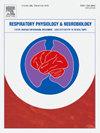Swallowing and ventilation patterns in stable COPD patients: An observational study
IF 1.6
4区 医学
Q3 PHYSIOLOGY
引用次数: 0
Abstract
Our study aimed to investigate swallowing coordination by analyzing ventilatory patterns during of solids and liquids food intakes. Twenty-one patients with severe to very severe stable COPD (GOLD III and IV) underwent ventilation and swallowing recordings while performing standardized swallowing tasks. The results revealed that the expiratory-expiratory (EE) swallowing pattern was predominant, accounting for 80 % of swallows, with no significant differences between solid and liquid swallows. Non-EE patterns occurred in an average of 20.68 % of swallows per patient. Our results demonstrated an increased inspiratory time (IT) during liquid swallows compared to rest (1.05 ± 0.28 s vs 1.29 ± 0.22 s; p < 0.0125), as well as prolonged expiratory time (ET: 2.09 ± 0.78 s vs 3.42 ± 1.16 s; p < 0.001) and total respiratory cycle time (TT: 3.14 ± 1.03 s vs 4.70 ± 1.21 s; p < 0.01) during both solid and liquid swallows compared to rest. These changes resulted in a decreased IT/TT ratio during swallowing. Our findings confirm that the EE swallowing pattern remains predominant in stable COPD patients, consistent with observations in healthy individuals. Additionally, the study highlights significant alterations in ventilatory patterns during swallowing. These results contribute to a better understanding of the interplay between swallowing and ventilation in COPD and its potential implications for airways protection.
稳定期COPD患者的吞咽和通气模式:一项观察性研究。
我们的研究旨在通过分析固体和液体食物摄入时的通气模式来研究吞咽协调。21例重度至极重度稳定期COPD (GOLD III和IV)患者在执行标准化吞咽任务时进行通气和吞咽记录。结果显示,以呼气-呼气(EE)吞咽方式为主,占吞咽方式的80%,固体吞咽与液体吞咽无显著差异。每位患者平均有20.68%的燕子出现非ee模式。我们的研究结果表明,与休息时相比,液体吞咽时吸气时间(IT)增加(1.05±0.28s vs. 1.29±0.22s;p < 0.0125),以及呼气时间延长(ET: 2.09±0.78s vs. 3.42±1.16s;p < 0.001)和总呼吸周期时间(TT: 3.14±1.03s∶4.70±1.21s;P < 0.01)。这些变化导致吞咽时IT/TT比值降低。我们的研究结果证实,在稳定型COPD患者中,EE吞咽模式仍然占主导地位,这与健康个体的观察结果一致。此外,该研究还强调了吞咽过程中通气模式的显著改变。这些结果有助于更好地理解COPD患者吞咽和通气之间的相互作用及其对气道保护的潜在影响。
本文章由计算机程序翻译,如有差异,请以英文原文为准。
求助全文
约1分钟内获得全文
求助全文
来源期刊
CiteScore
4.80
自引率
8.70%
发文量
104
审稿时长
54 days
期刊介绍:
Respiratory Physiology & Neurobiology (RESPNB) publishes original articles and invited reviews concerning physiology and pathophysiology of respiration in its broadest sense.
Although a special focus is on topics in neurobiology, high quality papers in respiratory molecular and cellular biology are also welcome, as are high-quality papers in traditional areas, such as:
-Mechanics of breathing-
Gas exchange and acid-base balance-
Respiration at rest and exercise-
Respiration in unusual conditions, like high or low pressure or changes of temperature, low ambient oxygen-
Embryonic and adult respiration-
Comparative respiratory physiology.
Papers on clinical aspects, original methods, as well as theoretical papers are also considered as long as they foster the understanding of respiratory physiology and pathophysiology.

 求助内容:
求助内容: 应助结果提醒方式:
应助结果提醒方式:


